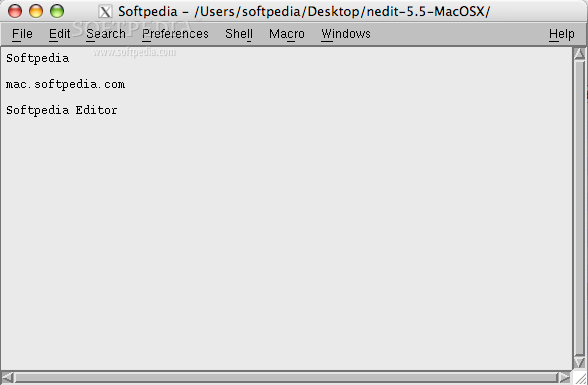고정 헤더 영역
상세 컨텐츠
본문
NEdit is a high-quality GUI text editor based on Motif.
Programmers new to the Mac platform, as well as newbie Mac coders often ask (or complain) about available development tools. Most often, Apple’s is recommended since it is free, and a pretty slick package. For cross-platform work, Metrowerks series has been with us since the early PowerPC days, and is very flexible in its support for multi-platforms. But with if you want to work in a language other than Objective-C,C, C or Java?
Or learn an entirely new language? How does the Macintosh fare?, a site devoted to Mac game developers, has put together a list of “alternative” development tools for Mac OS X. A good number of the tools listed are either free, or low-cost.
So, if you’re interested in playing around with Lua, Ruby, something similar to HyperCard, or one of the many BASICs, check out “.”. I like SubEthaEdit for small fileswhich is predominantly what I deal withI am, by no means, the hacker some of you guys are. But it has syntax support for any language worth using: C, C, C#, Java, Perl, Python, Ruby, Fortran 77/90/95, XML, HTML, bash shell, applescript, etc. Kind of like visual SlickEdit. What is cool is you can collaberate with others over the internet on the same document in real time. It also has a command line tool built into the Editor as well. IT’s nice, it works.
I might have to check out NetbeansCodewarrior I don’t like so muchbut that’s probably because I really am not much of a codewarrior myself. The power of VI comes in it’s keyboard binding, not really as a development environment. But it does have code-folding and a limited java intellisense (only on windows and pretty static from what I’ve seen). Eclipse and IDEA both have vi keybindings, but the real power of these development environments are that they actually understand the java language unlike something like ctags.
You don’t have to build your code in the traditional sense of hitting a button or a command line. Your source code is continually parsed for proper java syntax, so any syntax errors, warnings, or even refactoring advice shows up realtime. Then you have stuff like intellisense (method, member popup lists) and associated pop-up docs. I’d rather let the IDE do that stuff than alt-tabbing to browsers or books for API lookups. And then you have all of the refactoring abilities of these environments that only a real-time parser can give you. I love vim and never underestimate the power of printf debugging, but I also recognize that these development environments afford me the opportunity to concentrate on my implementation while the machine does some of the druge word.
In any case, here’s a link to an article about future programming paradigms and how text-oriented programming is outdated. “The only people that are floundering around helplessly are those unproductive people that still insist on using VI for java development when modern tools like Eclipse or IDEA are out there.” It’s funny how some people think that an IDE is counter productive while others thing using a text editor, debugger, and compiler is counter productive. The fact of the matter is it all depends on the programmer. I personally prefer using IDEs since it integrates all the tools I need into one program. Everything is there for me to use without having to switch to another utility.

A couple of my friends swear by vi or emacs, a seperate compiler, and a seperate debugger. In the end we can all get similar programs down in roughly the same amount of time. It just depends on what your are comfortable with. But if you know how to properly use the tools that you have you can be just as productive as the next guy. If somebody knows how to use vi for writing code, and enjoys doing it that way, they are certainly not floundering around.
Nedit Macro Commands
Strange that Qt wasn’t mentioned. Is no one using it? You don’t want to use Qt for the Mac, your user’s won’t like it.
Nedit Macros

While TrollTech claims that Qt is highly HIG-compliant, my experience with Qt apps on OS X is that they clearly look and feel non-Mac. For example, I have Lyx running: The toolbar consists of square gumdrop buttons (as opposed to a non-gumdrop button toolbar like in Mail.app), the file dialog is not the system dialog but a custom one, text in popup widgets is too far left, and the toolbar looks and behaves (esp in terms of customization) more like IE on Win than Safari.




